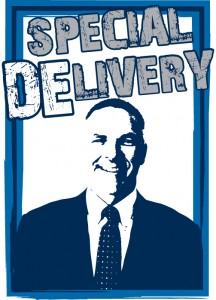Special DElivery: If it were up to the kids, what would they say?

MiHockey’s Darren Eliot discusses the hot topics of cross-ice play in 8U hockey, and the American Development Model in general, in his latest Special DElivery.
By Darren Eliot –
Even Michael Phelps must have started in a wading pool. That’s all I could think of as I watched the Olympics these past couple of weeks. The sprinters, too, surely found out they were fast by playing tag and never getting caught. And like the commercial that has been running about gymnast Jonathan Horton climbing to the ceiling in the middle of a department store at age 4, when his parents thought that tendency might warrant some nurturing through entry-level tumbling classes instead of curbing.
I was moved to view these Olympics through that prism for several reasons, most notably, though, because I keep trying to understand the angst and vitriol surrounding the playing surface debate for Mite hockey players. Make no mistake; this isn’t about a bunch of gloomy 8-year-olds griping that the ice surface isn’t big enough. This is about the business of youth hockey, which I understand. But I also know that, like the young sprinter running freely just to avoid being tagged, any eight year old on any sized sheet of ice will find a way to skate, pass and shoot and at the end of it, when asked if they had fun, they will say “yes”.
That’s true if it is 85 feet wide as in cross-ice, 100 feet long as in half-ice, 200 feet long as in full ice, or 400 feet long as in skating on, say, the Rideau Canal in Ottawa. In that situation, the kids may choose to modify the length of the ice surface depending on the size and number of the players and actually break into multiple games based on those very same dynamics. That’s a natural way for players to think and develop – make the ice surface fit the size and number of the players available. Simple.
So simple, in fact, that while I was keeping in touch with all things Olympic, I was also at various rinks on a daily basis. I happened to be in Suburban Ice Farmington Hills one morning and watched a group of pros skating. I recognized a couple of them and spoke with David Moss (our ‘Hometown Hero’ for this issue), who seemed to be heading up the loosely organized skate. They ran through some warm-up skating drills then onto some full ice drills. When it came time to play, though, they moved the nets closer to each blue line, approximating a half-ice game – configuring the ice surface to fit the numbers and the training needs.
I point this out because you won’t find many true hockey people who will argue the virtues of right-sized training when it comes to skill development. Anyone who rails on the “downside” for eight-year olds is disingenuous. I even heard one rink denizen explaining to a wide-eyed parent of a 7-year-old player that playing on smaller surfaces “hurts the development of the forward stride.” Better not tell David Moss and the boys that, as grown professionals, they are hurting their strides by not playing on the full 200-foot sheet.
So, spotting the crackpots with other agendas is the easy part. What to do is more difficult. This whole Mite rule controversy isn’t so much about what’s best for the kids – development of passion and skills – it’s about adults. It’s about adults competing. It’s about business. And that is a valid concern. If it were just about development, there would be no controversy. If left solely up to the kids, they’d say, “Let’s play some hockey!” That hasn’t changed. Kids just want to hit the ice with their friends and have fun. Even as we watch these Olympic Games, we know that these elite athletes began as little kids, with little kid pursuits – running, climbing, swimming… playing.
That’s no different than when I began playing at Morningside Arena in Burlington, Ontario. Our Thursday night practices were on an outside square sheet of ice, under a string of lights that cast rays in some spots, but produced as many shadows as they did lighted areas. That was my thought as a beginner goalie as I peered into the semi-darkness to find the puck. I still remember the snowy, fenced-in practice rink – no Zamboni or boards out there – and the fun we had in the half-lit environment. We were 9 years old and we were playing hockey. That’s all that mattered.
But, adult intervention and supervision has changed youth sports – all sports – since then. It is pervasive. In many cases, it is over the top. But it is here to stay. It is part of the business, which is work. By definition, that’s the opposite of play, which is all the kids want to do: anywhere, anytime, on any sized rink.

